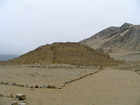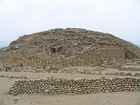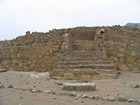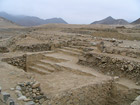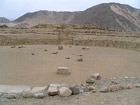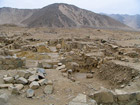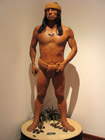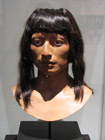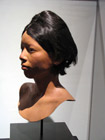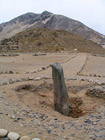|
Caral - cradle of American civilisation
| |
Irina Nazarova, Peru
January, 2007
|
|
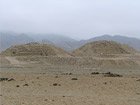 |
It is very difficult for a contemporary human to believe that the history of humanity still has got a place for unexpected discoveries. Of course, the «golden age» of archeology seemed to have passed in the Old World, but the New World still keeps «blank spots» for future historians and archaeologists. One of the most important recent discoveries is the most ancient civilisation of America – Caral that got its name after a little village in 158 kilometers to the North of Lima.
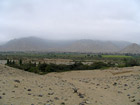 |
In the valley of Supe river, on the territory of which archaeologists counted the ruins of 18 settlements, investigations started even at the dawn of XX century. But the discoveries did not please by their significance. The situation was complicated by absolute absence of ceramics, the analysis of which has always helped the archaeologists to determine the age and level of civilisation development. At that time it didn't even occur to anyone that the discovered ruins belong to a pre-ceramic period (ceramics appeared in the South America around 1800 B.C.).
And only in 1970 archaeologist Feldman, making archaeological excavations in Aspero (a settlement of fishermen at the coastline) made a suggestion that the absence of ceramics dates back the age of that site of ancient settlement to the third century B.C. But not all scientists agreed with that theory.
In 1994 the Peruvian archaeologist Ruth Shady started to treat that matter seriously. Whether it was her intuition or professional approach that prompted her that numerous hills and dunes of the valley should hide something tremendous. It was in Caral that in 1996, initiated by her, they started dimensioned digs with the financial help of National Geographic.
The main question that tormented the archaeologists – the age of the civilisation – could be answered only when they found organic remains – shicras – nets made of plant fibres filled with stones. Scientists from the University of Illinois carried out a radiocarbon analysis (carbono-14) and determined their age – about 5 thousand years. Later few more dozens of tests were performed that only confirmed and specified the age of the most ancient in America city – 2700-2900 year B.C. The date of end of that civilisation according to different sources varies between 2000 to 1500 year B.C.
Why is this ancient civilisation so important for history? Of course not only by its most ancient age on the territory of America.
Caral appeared approximately at the same time as the first world civilisations in Egypt and Mesopotamia. About 6 thousand years ago the humanity started transition from savagery to civilisation that was marked by construction of cities, huge structures, pyramids, etc. And one of the most important tasks of archaeology has always been the search of ciudad-madre – the first city. In the Old World it was complicated as all civilisations to a more or less extent exchanged knowledge and goods, as well as all new structures, as a rule, were built on the site of the previous ones and traces of initial culture were very frequently destroyed.
Caral faced another situation: first, the city was built at the «empty area». Second, this region of Peru was developing in isolation from all other America, the peoples of which at that period were at much lower level of development and by no means could influence Caral. After all Mesoamerica, which is the centre of civilisation of the New World, was behind in its development by fifteen hundred years. That is why it is Caral that can be easily called a ciudad-madre, and analysing its development we can answer the question, what prompted the «barbarians» to cross the border and start a long way of civilisation.
One of the most popular at present theories is that the impetus to development have always been wars. They make the «barbarians» change to a settled way of life, build cities, protective structures, concentrate power, and so on. Caral completely rejects that theory. In every ancient civilisation there are always traces of war whether in architecture or art, but in Caral there have been found absolutely no signs of any conflict. During excavations they did not find either defensive structures or weapon, or reflection of war in the works of art. In our restless times it is impossible to imagine a civilisation that existed for almost a thousand years without any military conflicts. But the first American state peacefully coexisted with its neighbours, and its development was conditioned by peaceful motives and its ties were based on peaceful reasons.
The main conclusion to which the researches have come, - the impetus to development of Caral, the main force for its existence was trade. It was a commercial centre, the connecting-link for a vast territory from the shores of the Pacific ocean to the Andes and right up till the selva.
Caral is located in practically deserted area of the Supe river valley. But owing to an extensive irrigation system its residents manged to turn the deserted lands into fertile soils, where they grew practically the same things as the contemporary Peruvians grow: beans, pumpkin, pepper. The main «export» goods was cotton. The shreds of fishing nets pointed to not only that the Caralians used to catch river fish and shrimps, but to a bigger extent they used to make nets and changed those for sea fish with the residents of the coastline. As the scientists established the ration of the Caral population included a lot of dry fish and clams. During excavations they have also found the objects from remote mountainous areas and selva: wood, different herbs and seeds, including achiote, cacti, coca seeds, pipes made condor bones that lives inly in the mountains, and etc.
All this confirms the suggestions of archaeologists that Caral was a «link centre» between the coastal area, selva and mountains.
But Caral was not only a commercial but a religious centre as well. It was religion that organised and controlled the society. The rulers were simultaneously priests, and organisers and scientists. They managed the complete life of the population, organised social works, distributed benefits, composed the astronomic calendar, according to which they carried out both agricultural and religious rituals. It was nobody else but gods through the lips of priests used to explain to ordinary citizens when to sow and crop the harvest, how to arrange irrigation canals, which pyramids and ceremonial centers to be built by joint efforts. The prestige of religion was unusually high, the gifts to gods were brought by coastal, mountainous, selva residents in exchange for knowledge and advice.
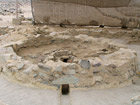 |
|
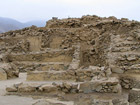 |
The most widespread means of communication with gods was the fire. In Caral in practically all structures both residential and ceremonial, they found sacred hearths in which they burnt gifts to gods. And the main fire had to go on for ever. It might have been Altar Circular, which has a complicated system of ventilation for keeping the fire on.
Much attention was paid to ritual actions, at that for establishing communication with gods they played the flutes made of condor bones and different hallucinogenic agents. Achiote was one of these agents. This plant is still used for the selva aboriginals to dye leather and make pictures on it. With the help of achiote the ancient shamans used to fall into a trance. Very often in ancient Caral along with pounded coca leaves they mixed the powder of cal – to intensify the effect. Till now ordinary Indians chew coca leaves mixed with that powder.
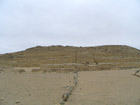 |
|
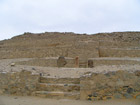 |
Excellent organisation of social works, scientific and technical knowledge helped them to build numerous pyramids, palaces, residential structures and store houses at the territory of 66 hectares. The most important and largest political, administrative and religious centers was Piramide Mayor of almost 30 meters high, with recessed round square, where different ceremonies were held. Here they found one of scarce ritual burial places. By the remainders of the young man found there, the possible appearance of the Caral resident was reconstructed.
By the way, one of the mysteries of Caral is that practically no human remainders have been found. Only a few ritual burial places were found but not a single cemetery was ever found. The deceased might have been cremated, but there still no confirmation to that.
Among other interesting discoveries we may mention the first in America quipu – strings with knots. They were used for storing and passing the information. In a couple of thousand years such strings with knots were extensively used by the Incas.
As was already stated the residents of Caral did not know pottery. However, they made anthropomorphous figures of unburnt clay and by them one could judge what importance was given to details. Depending on the social status of a person they were not only clothed differently, but they has different hair-dresses, which were rather complicated and unusual.
In the settlement of Chupacigarro near Caral the geoglif of 48 by 26 meters was found depicting the profile facing the west. It is thought to be used for astronomic calculations, weather and natural phenomena forecasts.
All these findings confirm the high level of scientific, astronomic, technological knowledge, culture and art of the ancient civilisation of Caral.
And we cannot help but mention one the recent guesses: Caral was also a cradle of quechua – one of the most widespread languages at the continent. The new theory contradicts the generally accepted version about appearance of quechua in the Andes, but it has a lot of supporters.
Today we can be absolutely sure to say that Caral used to be a model for further civilisations (which was especially brightly revealed in the culture of Chavin). Study of the past of Caral will force to review many theories and rewrite many textbooks in history. The works in Caral are permanently carried out and almost every day there are important discoveries, so there is still something to do for archaeologists and historians.
|




